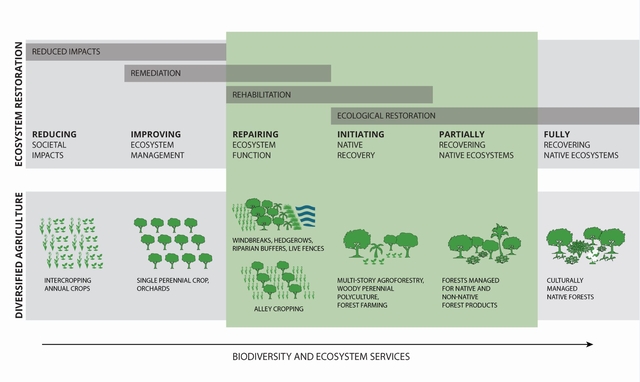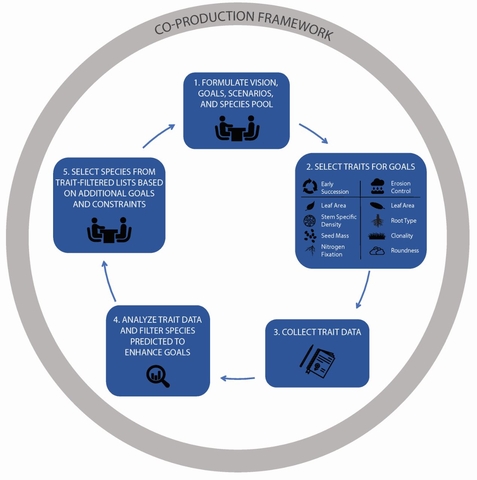Despite significant attention to the benefits of practices along an agroforestry continuum (Fig. 1), disconnects between agroforestry research and practice may limit widespread implementation. Agroforestry research often focuses on a limited number of species and commodity crops (Wolz & DeLucia, 2018). However, many farmers and communities are interested in growing and using other species, especially native plants that produce non-timber forest products, which may have been traditionally managed to increase production but not necessarily planted in agricultural settings.
This disconnect between the species included in research and those of interest to farmers and communities may constrain agroforestry establishment globally (Dumont et al., 2019). Thus, a critical challenge is how to improve the design of research so that studies are both inclusive of local needs and produce findings useful to other sites.
In a perspective article that appears in the early view of Conservation Science and Practice (https://conbio.onlinelibrary.wiley.com/doi/10.1111/csp2.250), we present a method for selecting species for agroforestry and restoration research and demonstration projects that can improve research and practice connections (Fig. 2). This method integrates two well-established research approaches: co-production and functional trait design.
Co-production of knowledge is a process for bringing together scientists and practitioners to iteratively create new knowledge and practice, and is an effective strategy for focusing research on local priorities, including locally important species (Norström et al. 2020).
Functional trait design uses the characteristics of species, like rooting depth, to predict relationships between species and ecosystem services (Ostertag et al. 2015). Findings from research designed with this approach are linked to species traits rather than species identities alone. For example, findings from this approach might state “rooting depth diversity increases sediment retention” rather than “intercropping maize and walnut increases sediment retention”. This allows study findings to be applied to sites beyond just those where the study species are appropriate.
Embedding a functional trait approach to species selection within a co-production framework has several advantages over applying either approach alone. One benefit is that an integrated approach is flexible to including traits and trait values based on indigenous and local knowledge, which helps focus research on local priorities as well as overcome trait data limitations. Another benefit is that research findings can be transferred to other sites even if actual species selected in co-production are site specific. Research outcomes thus have current and future utility.
However, common challenges of co-production still remain with an integrated approach. For example, constraints of research design can conflict with stakeholder goals, and unequal power dynamics can undermine the process and outcomes (Turnhout et al., 2020).
Overall, integrating co-production and functional trait approaches to research design can improve inclusion of indigenous and local knowledge and locally-relevant species while still producing generalizable results, which is critical for inclusive, scalable agroforestry solutions.


References
Dumont, E.S., Bonhomme, S., Pagella, T.F. & Sinclair, F.L. (2019). Structured stakeholder engagement leads to development of more diverse and inclusive agroforestry options. Experimental Agriculture, 55, 252–274.
Gann, G.D., McDonald, T., Walder, B., Aronson, J., Nelson, C.R., Jonson, J., Hallett, J.G., Eisenberg, C., Guariguata, M.R., Liu, J., Hua, F., Echeverría, C., Gonzales, E., Shaw, N., Decleer, K. & Dixon, K.W. (2019). International principles and standards for the practice of ecological restoration. Second edition. Restoration Ecology, 27, S1–S46.
Hastings, Z., Ticktin, T., Botelho, M., Reppun, N., Kukea‐Shultz, K., Wong, M., Melone, A. & Bremer, L. (n.d.). Integrating co-production and functional trait approaches for inclusive and scalable restoration solutions. Conservation Science and Practice, n/a, e250.
Naeem, S. & Wright, J.P. (2003). Disentangling biodiversity effects on ecosystem functioning: deriving solutions to a seemingly insurmountable problem. Ecology Letters, 6, 567–579.
Norström, A.V., Cvitanovic, C., Löf, M.F., West, S., Wyborn, C., Balvanera, P., Bednarek, A.T., Bennett, E.M., Biggs, R., de Bremond, A., Campbell, B.M., Canadell, J.G., Carpenter, S.R., Folke, C., Fulton, E.A., Gaffney, O., Gelcich, S., Jouffray, J.-B., Leach, M., Le Tissier, M., Martín-López, B., Louder, E., Loutre, M.-F., Meadow, A.M., Nagendra, H., Payne, D., Peterson, G.D., Reyers, B., Scholes, R., Speranza, C.I., Spierenburg, M., Stafford-Smith, M., Tengö, M., van der Hel, S., van Putten, I. & Österblom, H. (2020). Principles for knowledge co-production in sustainability research. Nature Sustainability, 3, 182–190.
Ostertag, R., Warman, L., Cordell, S. & Vitousek, P.M. (2015). Using plant functional traits to restore Hawaiian rainforest. Journal of Applied Ecology.
Wolz, K.J. & DeLucia, E.H. (2018). Alley cropping: Global patterns of species composition and function. Agriculture, Ecosystems and Environment, 252, 61–68.
